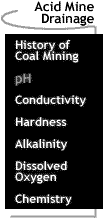

 |
Acid Mine Drainage: pH The pH of a liquid is the negative logarithm of the concentration of hydrogen ions (catinos) in the solution. pH = - log [H+] Because the pH scale is logarithmic, every single unit change in pH actually represents a ten fold change in the number of hydrogen ions in a solution. The pH of natural water depends on several factors, which include the bicarbonate buffering system, types of rock, types of soil, and nature of discharged pollutants. The concentration of carbonates and carbon dioxide is the main influence on the pH of clean water. High concentrations of bicarbonate produce alkaline waters (high pH), while low concentrations usually produce acidic waters (low pH). Acidic and alkaline compounds can be weathered into the stream from the different types of rock present. When limestone (CaCO3) is present, carbonates can be released, affecting the alkalinity of the water. The types of soil in the drainage area also affect the pH. Drainage water from forests and marshes is often slightly acidic, due to the presence of humic acids produced by decaying vegetation. Nitrogen oxides (NO, NO2) and sulfur dioxide (SO2) from automobile and power plant emissions are converted into nitric acid (HNO3) and sulfuric acid (H2SO4) in the atmosphere. These acids can affect the pH of streams by combining with moisture in the air and falling to the earth as acid rain or snow. Surface waters can sometimes act as weak buffer solutions depending on the concentrations of carbonates and bicarbonates.
Changes in pH can also affect aquatic life indirectly by altering other
aspects of water chemistry. Low pH levels accelerate the release of heavy metals from
sediments on the stream bottom. The heavy metals can reduce the chance of survival of most
aquatic organisms. Image data: Courtesy
of Dr. Ben Stout [ Acid
Mine Drainage: History of Coal Mining / pH / Conductivity / [ Sewage ] [ Agriculture
] [ Dredging ] [ Home ] [ Teacher Pages ] [ Modules & Activities ] |
HTML code by Chris Kreger
Maintained by ETE Team
Last updated November 10, 2004
Some images © 2004 www.clipart.com
Privacy Statement and Copyright © 1997-2004 by Wheeling Jesuit University/NASA-supported Classroom of the Future. All rights reserved.
Center for Educational Technologies, Circuit Board/Apple graphic logo, and COTF Classroom of the Future logo are registered trademarks of Wheeling Jesuit University.